Lakes and shallow water
What is a lake or shallow open water wetland?
True lakes are greater than two metres deep. Some of our larger wetlands include shallow lakes and open water areas less than two metres deep, often with marsh wetlands around the edges. Northland has more than 600 lakes including some of the best and biggest dune lakes in the country. Dune lakes can be found in only five places in the world and are globally endangered. Lakes get their water from many sources including rain, runoff, ground water and geothermal activity. Volcanic lakes are a feature of central Northland. Water clarity and quality depends on the type of lake and its condition. Good dune lakes have clear, low nutrient water while others have nutrient rich water as a result of grazing or runoff from surrounding land.
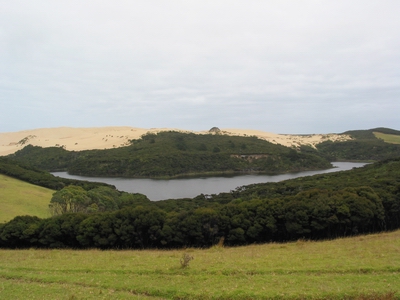 Lake Ngakeketa, a dune lake in the Far North.
Lake Ngakeketa, a dune lake in the Far North.
Why are lakes and wetlands with open water important?
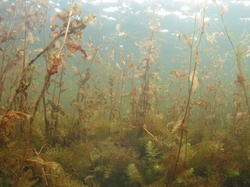 Native macrophyte beds in Te Paki Dune Lake (Photo: NIWA).
Native macrophyte beds in Te Paki Dune Lake (Photo: NIWA).
Lakes are home to a unique range of native algae and aquatic plants. Because there are few lakes left with good water quality many of these plants are now threatened. There are many fish and water birds that use open water, some of which like scaup, and brown teal are rare. Lakes are important for storing clean water and can be a real asset on farms or in pine forests. They can also help reduce peak flood levels during storms.
Many of the best Northland lakes are popular for recreational swimming and boating. Duck shooting is a widespread sport in areas of shallow open water while eels are harvested for food.
Vegetation
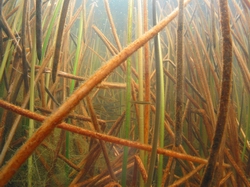 Inanga in Lake Morehurehu (Photo: NIWA).
Inanga in Lake Morehurehu (Photo: NIWA).
Vegetation of open water varies depending on the type of bottom sediment and the water quality. Clear lakes usually have a dense bottom cover of native macrophyte plants including freshwater charophytes (algae), pond weeds and milfoils. In Lake Taharoa at Kai Iwi plants grow down to around 27 metres, the deepest growing vegetation of any lake in the North Island. On lake margins there may be reed beds of raupō, kuta, or lake clubrush. Rare plants of shallow water include the tiny endangered water lily relative Trithuria inconspicua, native milfoil Myriophyllum robustum and the native bladderwort Utricularia australis which catches insects in its tiny bladders. Lake margins can be dry over summer leading to low growing plant communities called turfs. A number of tiny rare native annual plants grow in these turfs. Sadly many lakes have been infested by introduced water weeds such as oxygen weeds and hornwort.
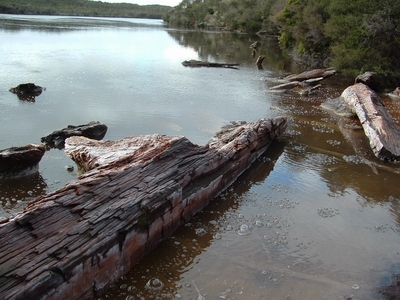 Lake Waiparaheka geothermal lake, Ngawha is unusual because aquatic plants can't grow in the geothermal water.
Lake Waiparaheka geothermal lake, Ngawha is unusual because aquatic plants can't grow in the geothermal water.
Animals
Open water and lagoons are breeding grounds for many birds and native fish such as common bullies. Kōkopu, inanga (Galaxias spp.) and eels may be present. Shallow water provides habitat for water fowl such as scaup, teal, grebes, dabchicks and wading birds like white faced herons.
Looking after your lake or shallow water
You may be eligible for a Northland Regional Council Environment Fund grant for up to 50 percent of the costs of wetland fencing, pest control and planting.
Nutrients
The biggest issue for Northland's lakes is decreasing water quality caused by increased nutrients from fertilisers, land runoff, septic tanks, tracks and roads and stock access. Smaller or shallower water bodies and those with big catchments are most affected. Added nutrients – especially phosphates and nitrates – cause the water to increase in fertility (eutrophication) and can lead to toxic algal blooms. Where weeds such as oxygen weed are present, eutrophication can cause lakes to clog with rotting weed. The water clarity may become so bad that all vegetation growing on the bottom dies and the water is no longer useable or safe to swim in. Unfortunately once nutrients are in a lake they are virtually impossible to remove.
What you can do to prevent nutrients entering lakes and shallow water:
- Manage the catchment area that feeds the lake – avoid pugging and over-grazing;
- Prevent fertiliser drift and runoff;
- Don't spread farm effluent near lakes especially on free-draining soils;
- Avoid building septic tanks, offal pits etc near lakes;
- Fence stock away from lake margins leaving an adequate buffer to filter runoff; and
- Stop runoff entering lakes from farm tracks, forestry operations and earthworks.
Contact the Northland Regional Council as you may require sediment ponds and need a resource consent.
Stock
Effluent, especially urine from farm animals grazing on a lake margin increases nutrients in the water. Pugging also causes problems with water quality. Cows browse softer marginal reed beds and break raupō crowns causing dieback.
Contact the Northland Regional Council for advice on fencing.
Plant pests
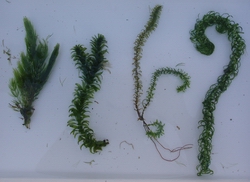 Water weeds left to right – hornwort, Egeria, Elodea, and Lagarosiphon. Oxygen weeds (Egeria, Elodea and Lagarosiphon) and hornwort cause major problems in water bodies. Weeds are commonly moved around on boats, machinery and eel nets. These weeds can grow out of control displacing all native plants especially in lakes affected by nutrient increases.
Water weeds left to right – hornwort, Egeria, Elodea, and Lagarosiphon. Oxygen weeds (Egeria, Elodea and Lagarosiphon) and hornwort cause major problems in water bodies. Weeds are commonly moved around on boats, machinery and eel nets. These weeds can grow out of control displacing all native plants especially in lakes affected by nutrient increases.
Dense weed beds may start to rot causing algal blooms and making the water toxic to stock and unsafe for swimming. There are other weeds we don't want in Northland which are a problem further south, e.g. yellow flag iris, Hydrilla.
Contact a Northland Regional Council Biosecurity Officer for advice.
You can keep weeds out of water bodies by:
- Checking, cleaning and drying all equipment, boats, trailers, nets etc;
- Making sure visitors get the check, clean, dry message;
- Fencing stock out to reduce disturbance and prevent weed spread; and
- Washing and drying equipment and machinery after working in weedy areas or off your land.
Pest fish
Fish such as koi carp, catfish, feral goldfish, tench, perch and rudd do a great deal of damage in water bodies. They stir up the bottom, increase nutrient levels and algal concentrations, eat aquatic plants, compete with native species, and prey on native fish and invertebrates. Black mudfish, native fish and frogs can't cope with introduced gambusia (mosquito fish). It is illegal to introduce pest fish to Northland. Remember that you can bring them in unintentionally as eggs or juveniles on boats and fishing gear so make sure you and visitors to your lake always follow the check, clean, dry message.
Animal pests
When it comes to animal pests, there are some basic rules of thumb:
- Wetland birds respond well to basic pest control.
- Pest animals around water bodies include possums, stoats, weasels, ferrets, hedgehogs, rats and cats.
- Wandering dogs harass or kill native birds.
- Fencing your lake is great but may favour pest predators. Fortunately basic predator control is as easy as a line of traps or bait stations around the edge.
Contact a Northland Regional Council Biosecurity Officer for advice on the best pest control methods for your situation and to apply for funding
